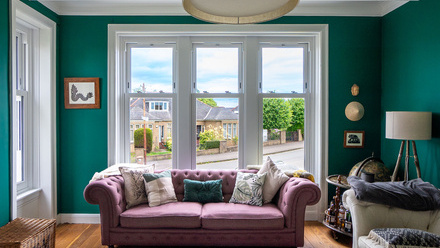Humidity resilience in home design: strategies for UK Architectural Technologists
Recent insights from the Met Office's HadISDH.extremes dataset underscore the growing importance of humidity control in building design. To create homes that are not only energy-efficient but also provide a healthy and comfortable living environment, it is essential to incorporate condensation and humidity-resistant features into building design. And to do that, we need to first understand it.
Humidity is a relative measure, expressed as Relative Humidity (RH), which reflects the amount of moisture air can hold at a given temperature. As air temperature rises, so does its capacity to hold moisture. Conversely, when air cools, its relative humidity increases, leading to condensation when the RH reaches 100%. Condensation occurs because the cooler air cannot retain the same amount of moisture, which then precipitates onto colder surfaces – which was the cause of the air cooling – such as windows or walls.
Condensation is a common issue in residential settings, particularly on single and double-glazed windows, where the temperature difference between the air adjacent to the window surface is colder in winter months, resulting in moisture accumulation. Triple-glazed windows are more effective in preventing condensation because the additional pane of glass ensures that the internal surface of the window is warmer. This reduces the likelihood of reaching the dew point (the temperature at which moisture falls out of the air), so condensation is not formed. It is also worth noting that as humans we are much more sensitive to radiant heat than air temperature; colder surfaces make us feel less comfortable.
It is not just the temperature of the internal glazing that affects the RH and subsequently the levels of condensation. A high-performance window should be well-sealed to prevent the ingress of external air, which can introduce colder temperatures and create conditions conducive to condensation. By maintaining a consistent internal temperature, they help keep the relative humidity at optimal levels, reducing the risk of moisture-related issues such as mould growth, which begin to thrive in environments where RH exceeds 60%.
High-performance doors are also particularly effective in this regard. These offer superior thermal performance, ensuring the internal pane remains warmer, which in turn helps maintain a stable indoor environment. This not only enhances energy efficiency but also contributes significantly to the comfort and health of the occupants by minimising condensation and the related risks of mould and mildew.
One of the most effective strategies to manage indoor humidity is integrating Mechanical Ventilation with Heat Recovery (MVHR) systems into residential designs. MVHR systems work by extracting stale, moisture-laden air from "wet" rooms such as kitchens and bathrooms, and replacing it with fresh, filtered air from outside. The system significantly reduces the relative humidity indoors, while improving air quality.
The key to MVHR's effectivenesss to do this lies in its heat exchange processes. As stale air is expelled, it passes through a heat exchanger, where around 90% of the heat is transferred to the incoming fresh air. This process not only helps maintain a comfortable indoor temperature but also lowers the RH of the incoming air, as the heat exchange reduces its moisture content. Additionally, the filters in MVHR systems can remove pollutants such as particulates and pollen, further enhancing the indoor environment.
During the summer months, MVHR systems should operate in a summer bypass mode, where the coolness of the building is preserved during the day and active cooling takes place at night when temperatures are lower, reducing the need for active cooling. Although less effective at controlling high RH levels in summer, this mode helps prevent overheating by maintaining lower indoor temperatures. The cooler nighttime air, often around 15°C in the UK, is drawn in and distributed throughout the house, aiding temperature regulation without adding excess moisture.
Effective humidity control in residential buildings goes beyond just technology – it requires thoughtful design strategies. In the UK, where moisture levels are naturally high, it's crucial to design homes that minimise the potential for excess humidity.
Another critical aspect of moisture management is educating occupants on how to reduce indoor humidity. Everyday activities such as cooking and bathing contribute significantly to moisture levels, adding as much as 9-15 litres of moisture into the air for an average family. This is why controlling the moisture levels through ventilation with heat recovery is so key if we are to minimise our energy use. Activities like drying clothes indoors also add significant levels of moisture into the air and should be avoided.
Other measures can be taken to reduce the level of moisture in the air caused by daily activities such as installing a heat pump-enabled tumble dryer – which is inexpensive to operate – and ensuring that extractor hoods in kitchens are vented to the outside wherever possible.
To create a healthy and comfortable living environment, it is essential to maintain indoor RH levels between 40 and 60%. At these levels, the risk of bacteria, viruses, and dust mites thriving is minimised, reducing potential health hazards. Maintaining consistent radiant heat on surfaces, such as walls and windows, helps combat condensation by keeping surfaces warm enough to prevent moisture from settling.
The challenges of managing indoor humidity in residential buildings will only increase as climate change intensifies. By incorporating high-performance windows, MVHR systems and thoughtful design strategies, architects and technologists can create homes that not only withstand the impacts of rising humidity, but also provide energy-efficient, healthy, and comfortable living environments. The future of residential architecture in the UK will depend on our ability to adapt to these new environmental realities, ensuring our homes remain sanctuaries from the increasingly unpredictable climate outside.
This article originally appeared in AT Journal issue 152






